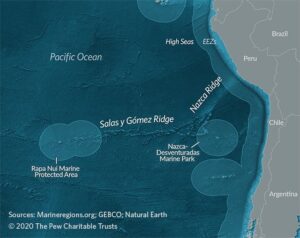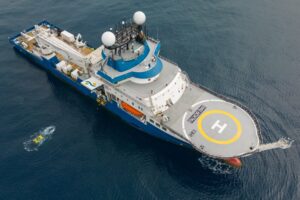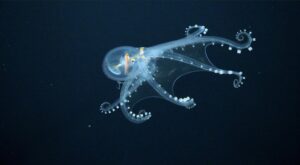Q&A: Exploring the Salas y Gómez and Nazca Ridges
Blog
In November 2023, the Blue Nature Alliance launched a new partnership with the Coral Reefs of the High Seas Coalition (CRHS) to advance protections in the Salas y Gómez and Nazca ridges, an ecologically and culturally important area of the high seas spanning 2,900 kilometers off the coast of Chile and Peru.
 Between January - April 2024, the Alliance and CRHS are working together with the University of Texas Rio Grande Valley, the University Católica del Norte, and others to support two scientific expeditions through the Schmidt Ocean Institute Falkor (too) Vessel. These cruises will strengthen our understanding of the region’s biodiversity and connectivity, and reinforce the need for protections in Salas y Gómez and Nazca ridges, as well as the high seas more broadly. In this Q&A, we hear from the expeditions’ Lead Scientist, Dr. Erin E. Easton, and Coral Reefs of the High Seas Director, Haydée Rodríguez.
Between January - April 2024, the Alliance and CRHS are working together with the University of Texas Rio Grande Valley, the University Católica del Norte, and others to support two scientific expeditions through the Schmidt Ocean Institute Falkor (too) Vessel. These cruises will strengthen our understanding of the region’s biodiversity and connectivity, and reinforce the need for protections in Salas y Gómez and Nazca ridges, as well as the high seas more broadly. In this Q&A, we hear from the expeditions’ Lead Scientist, Dr. Erin E. Easton, and Coral Reefs of the High Seas Director, Haydée Rodríguez.
Who is aboard the Falkor (too) vessel and what are the goals of the expedition?
Dr. Easton: The team consists of 24 on-board members of the science team from 14 organizations in 5 countries, including 14 team members from Chile, including the first Rapa Nui marine biologist, 8 student scientists, and 9 early-career scientists. This work is being conducted with the support of the Rapa Nui Sea Council (Koro Nui o te Vaikava) with only the second female elected to this council participating as an observer. We will also have two additional Rapa Nui citizens on board, Tauroa Aguilera and Serafina Moulton.
The goals of this expedition are (1) to conduct video surveys and obtain collections of selected marine organisms to characterize the seafloor communities; (2) to provide insights into the potential effectiveness of large-scale marine protected areas (LSMPA) in preserving seamount biodiversity, and (3) to provide educational resources and opportunities, with a focus on local stakeholders from Rapa Nui and continental Chile.
“Discovery, a desire to solve puzzles, a passion to collaborate with fellow scientists and local communities to achieve our goals, and the pride of engaging and training the next generation of marine scientists inspires me to do this work.”

Can you describe a typical day in your life on the Falkor (too)?
Dr. Easton: On days when we are diving, I start my mornings in Remote Operated Vehicle (ROV) Mission Control, where the Science team and I work with the pilots and media specialists to conduct live streams of our dives and collect samples. When the ROV comes to the surface, we process everything collected by taking high-resolution macro images of each sample, dissecting subsamples when appropriate, and storing the specimens for subsequent analysis in our lab onshore. I also support the team with outreach activities on board to engage and inform the general public about what we are discovering.
Why is it important to study the species in the Salas y Gómez and Nazca ridges?
Dr. Easton: On this cruise, we are exploring the ecosystems of the Salas y Gómez Ridge seamounts and oceanic islands. The Salas y Gómez ridges are an underwater mountain chain that extends 2,900 kilometers offshore of Chile, comprised of approximately 110 seamounts and two oceanic islands, Rapa Nui and Motu Motiro Hiva (also known as Easter Island and Salas y Gómez, respectively). Much of the western extent lies in waters under the national jurisdiction of Chile, but the eastern extent lies in the high seas, in waters outside any national jurisdiction. This cruise will be the first to explore several of these seamounts and the first to use an ROV capable of sampling biodiversity from the seafloor.
The information we obtain will provide the scientific basis for continued management of the region’s existing marine protected areas (MPAs), and lay the foundation for the creation of new MPAs on the high seas portion of the ridges. For example, if we are able to prove that the biodiversity present on each seamount is distinct, it would highlight the need for protecting every seamount (including those on the high seas) so as to not risk losing swaths of unique, likely endemic species.
Can you characterize your experience on the first cruise, and your initial observations from the region so far?
 Dr. Easton: The first cruise, which ran from January 8 - February 11, was extremely successful. We began this effort expecting to observe new species, but the number we observed far exceeded our expectations. After analysis of the videos and collections on shore, we expect to have over 150 new reports for the region and over 100 potential new species. Having physical specimens of these new species is a major achievement that will help advance our understanding of ocean biodiversity.
Dr. Easton: The first cruise, which ran from January 8 - February 11, was extremely successful. We began this effort expecting to observe new species, but the number we observed far exceeded our expectations. After analysis of the videos and collections on shore, we expect to have over 150 new reports for the region and over 100 potential new species. Having physical specimens of these new species is a major achievement that will help advance our understanding of ocean biodiversity.
It will take years, if not decades, to describe all of these species, but it is becoming clearer by the dive that each seamount harbors distinct communities that change with depth and seafloor features.
“I was fascinated by the sheer number of distinct communities we observed, especially those full of color reflective of the diverse communities, and the impressive size and therefore old age of a number of the sponges and coral colonies.”
Who are the members of the Coral Reefs of the High Seas Coalition and what are you working to achieve?
Rodríguez: The Coral Reefs of the High Seas Coalition (CRHS Coalition) is a partnership of more than 15 experts and organizations from across the globe committed to protecting valuable and exceptional high seas sites to ensure human wellbeing. The Coalition seeks to generate the science, strategic communication, and political support necessary to catalyze conservation progress. We do this by convening experts and organizations focused on conservation that previously worked in isolation. In the case of Salas y Gómez and Nazca, the CRHS Coalition has a team integrated across Oceana-Chile, Pew, ESMOI-Universidad Católica del Norte, and Conservation International.
Can you describe the Coalition’s partnership with the Blue Nature Alliance and your shared goals for the Salas y Gómez and Nazca ridges?
Rodríguez: In 2024, the CRHS Coalition and Blue Nature Alliance established a partnership that aims to reduce threats to Salas y Gómez and Nazca ridges by promoting conservation measures via the South Pacific Regional Fishery Organization (SPRFMO). Using the conservation tools currently available at the international level, we can advance meaningful protection for this critical high seas area while simultaneously preparing the site to be ready for official MPA designation under the highly anticipated mechanism established by the High Seas Treaty. This partnership enables us to apply lessons learned in the design and management of large-scale MPAs to set a positive precedent for high seas conservation elsewhere in the world.
How will the findings from the scientific expedition be used to advance protections in the high seas?
Rodríguez: Recently, the SPRFMO Commission tasked its Scientific Committee with conducting an analysis of the area and recommending possible conservation measures. This decision is the result of years of engagement with scientists, NGOs, Indigenous leaders, and government officials. Findings from the ongoing expeditions will inform the SPRFMO about the biological importance of this site and solidify the case for its conservation through a fishery closure.
“The outstanding team of regional and international scientists conducting this expedition and broadcasting their findings live are helping to bring the ecological richness of this site to a visible place, closer to our reality.”
The Blue Nature Alliance is currently partnering with the Coral Reefs of the High Seas Coalition (CRHS) and others to support the designation of 1.1 million square kilometers of new protections in international waters surrounding the Salas y Gómez and Nazca ridges. This engagement pursues protections by investing in science, policy, and communication activities to garner support for fishing closure within intergovernmental bodies regulating the convention area.
